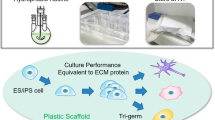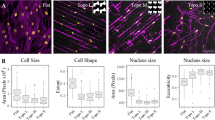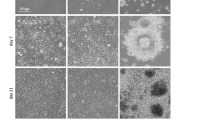Abstract
Both human embryonic stem cells and induced pluripotent stem cells can self-renew indefinitely in culture; however, present methods to clonally grow them are inefficient and poorly defined for genetic manipulation and therapeutic purposes. Here we develop the first chemically defined, xeno-free, feeder-free synthetic substrates to support robust self-renewal of fully dissociated human embryonic stem and induced pluripotent stem cells. Material properties including wettability, surface topography, surface chemistry and indentation elastic modulus of all polymeric substrates were quantified using high-throughput methods to develop structure–function relationships between material properties and biological performance. These analyses show that optimal human embryonic stem cell substrates are generated from monomers with high acrylate content, have a moderate wettability and employ integrin αvβ3 and αvβ5 engagement with adsorbed vitronectin to promote colony formation. The structure–function methodology employed herein provides a general framework for the combinatorial development of synthetic substrates for stem cell culture.
This is a preview of subscription content, access via your institution
Access options
Subscribe to this journal
Receive 12 print issues and online access
$259.00 per year
only $21.58 per issue
Buy this article
- Purchase on Springer Link
- Instant access to full article PDF
Prices may be subject to local taxes which are calculated during checkout






Similar content being viewed by others
References
Thomson, J. A. et al. Embryonic stem cell lines derived from human blastocysts. Science 282, 1145–1147 (1998).
Takahashi, K. et al. Induction of pluripotent stem cells from adult human fibroblasts by defined factors. Cell 131, 861–872 (2007).
Yu, J. et al. Induced pluripotent stem cell lines derived from human somatic cells. Science 318, 1917–1920 (2007).
Daley, G. Q. & Scadden, D. T. Prospects for stem cell-based therapy. Cell 132, 544–548 (2008).
Saha, K. & Jaenisch, R. Technical challenges in using human induced pluripotent stem cells to model disease. Cell Stem Cell 5, 584–595 (2009).
Amit, M. et al. Clonally derived human embryonic stem cell lines maintain pluripotency and proliferative potential for prolonged periods of culture. Dev. Biol. 227, 271–278 (2000).
Xu, C. et al. Feeder-free growth of undifferentiated human embryonic stem cells. Nature Biotechnol. 19, 971–974 (2001).
Stojkovic, P. et al. Human-serum matrix supports undifferentiated growth of human embryonic stem cells. Stem Cells 23, 895–902 (2005).
Braam, S. R. et al. Recombinant vitronectin is a functionally defined substrate that supports human embryonic stem cell self-renewal via alphavbeta5 integrin. Stem Cells 26, 2257–2265 (2008).
Li, Y., Powell, S., Brunette, E., Lebkowski, J. & Mandalam, R. Expansion of human embryonic stem cells in defined serum-free medium devoid of animal-derived products. Biotechnol. Bioeng. 91, 688–698 (2005).
Amit, M., Shariki, C., Margulets, V. & Itskovitz-Eldor, J. Feeder layer- and serum-free culture of human embryonic stem cells. Biol. Reprod. 70, 837–845 (2004).
Yao, S. et al. Long-term self-renewal and directed differentiation of human embryonic stem cells in chemically defined conditions. Proc. Natl Acad. Sci. USA 103, 6907–6912 (2006).
Ludwig, T. E. et al. Feeder-independent culture of human embryonic stem cells. Nature Methods 3, 637–646 (2006).
Ludwig, T. E. et al. Derivation of human embryonic stem cells in defined conditions. Nature Biotechnol. 24, 185–187 (2006).
Rodin, S. et al. Long-term self-renewal of human pluripotent stem cells on human recombinant laminin-511. Nature Biotechnol. 28, 611–615 (2010).
Li, Y. J., Chung, E. H., Rodriguez, R. T., Firpo, M. T. & Healy, K. E. Hydrogels as artificial matrices for human embryonic stem cell self-renewal. J. Biomedical Mater. Res. Part A 79, 1–5 (2006).
Gerecht, S. et al. Hyaluronic acid hydrogel for controlled self-renewal and differentiation of human embryonic stem cells. Proc. Natl Acad. Sci. USA 104, 11298–11303 (2007).
Villa-Diaz, L. G. et al. Synthetic polymer coatings for long-term growth of human embryonic stem cells. Nature Biotechnol. 28, 581–583 (2010).
Melkoumian, Z. et al. Synthetic peptide–acrylate surfaces for long-term self-renewal and cardiomyocyte differentiation of human embryonic stem cells. Nature Biotechnol. 28, 606–610 (2010).
Zou, J. et al. Gene targeting of a disease-related gene in human induced pluripotent stem and embryonic stem cells. Cell Stem Cell 5, 97–110 (2009).
Hockemeyer, D. et al. Efficient targeting of expressed and silent genes in human ESCs and iPSCs using zinc-finger nucleases. Nature Biotechnol. 27, 851–857 (2009).
Zwaka, T. P. & Thomson, J. A. Homologous recombination in human embryonic stem cells. Nature Biotechnol. 21, 319–321 (2003).
Anderson, D. G., Levenberg, S. & Langer, R. Nanoliter-scale synthesis of arrayed biomaterials and application to human embryonic stem cells. Nature Biotechnol. 22, 863–866 (2004).
Mei, Y. et al. Mapping the interactions among biomaterials, adsorbed proteins, and human embryonic stem cells. Adv. Mater. 21, 2781–2876 (2009).
Green, J. J. et al. Nanoparticles for gene transfer to human embryonic stem cell colonies. Nano Lett. 8, 3126–3130 (2008).
Tamada, Y. & Ikada, Y. Effect of preadsorbed proteins on cell-adhesion to polymer surfaces. J. Colloid Interf. Sci. 155, 334–339 (1993).
Underwood, P. A., Steele, J. G. & Dalton, B. A. Effects of polystyrene surface chemistry on the biological activity of solid phase fibronectin and vitronectin, analysed with monoclonal antibodies. J. Cell Sci. 104, 793–803 (1993).
van Wachem, P. B. et al. The influence of protein adsorption on interactions of cultured human endothelial cells with polymers. J. Biomed. Mater. Res. 21, 701–718 (1987).
Keselowsky, B. G., Collard, D. M. & Garcia, A. J. Integrin binding specificity regulates biomaterial surface chemistry effects on cell differentiation. Proc. Natl Acad. Sci. USA 102, 5953–5957 (2005).
Luther, E., Kamentsky, L., Henriksen, M. & Holden, E. Cytometry, New Developments, Vol. 75, 4th edn, 185–218 (2004).
Urquhart, A. J. et al. High throughput surface characterisation of a combinatorial material library. Adv. Mater. 19, 2486–2491 (2007).
Lipski, A. M. et al. Nanoscale engineering of biomaterial surfaces. Adv. Mater. 19, 553–557 (2007).
Engler, A. J., Sen, S., Sweeney, H. L. & Discher, D. E. Matrix elasticity directs stem cell lineage specification. Cell 126, 677–689 (2006).
Saha, K. et al. Substrate modulus directs neural stem cell behaviour. Biophys. J. 95, 4426–4438 (2008).
Tamada, Y. & Ikada, Y. Effect of preadsorbed proteins on cell-adhesion to polymer surfaces. J. Colloid Inter. Sci. 155, 334–339 (1993).
Thompson, M. T., Berg, M. C., Tobias, I. S., Rubner, M. F. & Van Vliet, K. J. Tuning compliance of nanoscale polyelectrolyte multilayers to modulate cell adhesion. Biomaterials 26, 6836–6845 (2005).
Delcorte, A. et al. ToF-SIMS study of alternate polyelectrolyte thin films: Chemical surface characterization and molecular secondary ions sampling depth. Surf. Sci. 366, 149–165 (1996).
Vickerman, J. C. ToF-SIMS: Surface Analysis by Mass Spectrometry (IM Publications, 2001).
Urquhart, A. J. et al. TOF-SIMS analysis of a 576 micropatterned copolymer array to reveal surface moieties that control wettability. Anal. Chem. 80, 135–142 (2008).
Meng, Y. et al. Characterization of integrin engagement during defined human embryonic stem cell culture. FASEB J. 24, 1056–1065 (2010).
Rowland, T. J. et al. Roles of integrins in human induced pluripotent stem cell growth on matrigel and vitronectin. Stem Cells Dev. 10.1089/scd.2009.0328 (2010).
Hayman, E. G., Pierschbacher, M. D., Ohgren, Y. & Ruoslahti, E. Serum spreading factor (vitronectin) is present at the cell surface and in tissues. Proc. Natl Acad. Sci. USA 80, 4003–4007 (1983).
Neuss, S. et al. Assessment of stem cell/biomaterial combinations for stem cell-based tissue engineering. Biomaterials 29, 302–313 (2008).
Guilak, F. et al. Control of stem cell fate by physical interactions with the extracellular matrix. Cell Stem Cell 5, 17–26 (2009).
Peerani, R. et al. Niche-mediated control of human embryonic stem cell self-renewal and differentiation. EMBO J. 26, 4744–4755 (2007).
Constantinides, G., Kalcioglu, Z. I., McFarland, M., Smith, J. F. & Van Vliet, K. J. Probing mechanical properties of fully hydrated gels and biological tissues. J. Biomechanics 41, 3285–3289 (2008).
Oliver, W. C. & Pharr, G. M. An improved technique for determining hardness and elastic modulus using load and displacement sensing indentation experiments. J. Mater. Res. 7, 1564–1583 (1992).
Cheng, Y-T. & Cheng, C-M. Scaling, dimensional analysis, and indentation measurements. Mater. Sci. Eng. 44, 91–149 (2004).
Hockemeyer, D. et al. A drug-inducible system for direct reprogramming of human somatic cells to pluripotency. Cell Stem Cell 3, 346–353 (2008).
Watanabe, K. et al. A ROCK inhibitor permits survival of dissociated human embryonic stem cells. Nature Biotechnol. 25, 681–686 (2007).
Acknowledgements
We thank C. Beard, R. Alagappan, P. Xu, P. Wisniewski, C. Araneo, K. Wood, J. Daussman, R. Flannery, D. Fu, E. Luther and Compucyte for technical support. We thank all the members of the Langer laboratory and Jaenisch laboratory for helpful discussions and comments on the manuscript. R.J. was supported by NIH grants R37-CA084198, RO1-CA087869 and RO1-HD045022. R.L., R.J. and D.G.A. are advisors to Stemgent and R.L. and R.J. are cofounders of Fate Therapeutics. Financial support for J.Y. and A.H. is from the Wellcome Trust 085246. K.S. is supported by the Society in Science: the Branco Weiss Fellowship. D.G.A., R.L. and Y.M. are supported by NIH DE016516. Z.I.K. was supported by the US Army through the Institute for Soldier Nanotechnologies, under Contract W911NF-07-D-0004 with the US Army Research Office.
Author information
Authors and Affiliations
Contributions
All of the authors developed experiments, participated in the generation and analysis of data and assisted in the writing of the manuscript.
Corresponding authors
Ethics declarations
Competing interests
The authors declare no competing financial interests.
Supplementary information
Supplementary Information
Supplementary Information (PDF 2491 kb)
Rights and permissions
About this article
Cite this article
Mei, Y., Saha, K., Bogatyrev, S. et al. Combinatorial development of biomaterials for clonal growth of human pluripotent stem cells. Nature Mater 9, 768–778 (2010). https://doi.org/10.1038/nmat2812
Received:
Accepted:
Published:
Issue Date:
DOI: https://doi.org/10.1038/nmat2812
This article is cited by
-
A guide to the organ-on-a-chip
Nature Reviews Methods Primers (2022)
-
A chemically-defined plastic scaffold for the xeno-free production of human pluripotent stem cells
Scientific Reports (2022)
-
Toward in Vitro Production of Platelet from Induced Pluripotent Stem Cells
Stem Cell Reviews and Reports (2022)
-
Functional regeneration and repair of tendons using biomimetic scaffolds loaded with recombinant periostin
Nature Communications (2021)
-
Complex polymer architectures through free-radical polymerization of multivinyl monomers
Nature Reviews Chemistry (2020)



